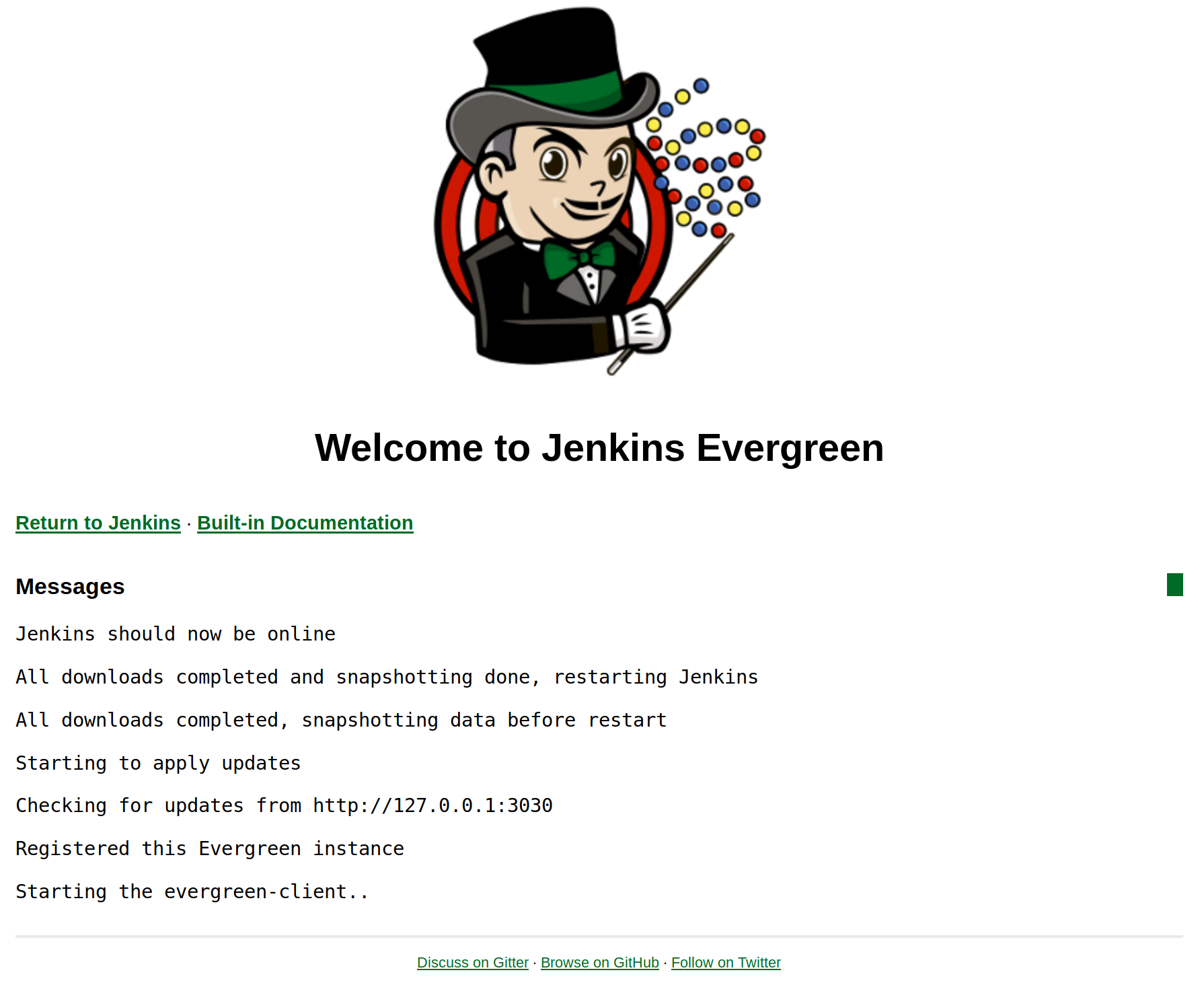docker volume create jenkins-evergreen-data && \
docker pull jenkins/evergreen:docker-cloud && \
docker run --name evergreen \
--restart=always \
-ti \
-p 8080:80 \
-v /var/run/docker.sock:/var/run/docker.sock \
-v jenkins-evergreen-data:/evergreen/data \
-e LOG_LEVEL=info \
jenkins/evergreen:docker-cloudEvergreen

Evergreen is an automatically updating rolling distribution system for Jenkins. It consists of server-side, and client-side components to support a Chrome-like upgrade experience for Jenkins users.
Jenkins Evergreen provides the end-user with a pre-assembled collection of legos that can be immediately used to implement CI [1] and CD [2] workloads. At the same time, this focus on end-users success in these well-defined scenarios will help the Jenkins project develop new features, and fix bugs, more rapidly than before.
Getting Started
|
Evergreen is currently in beta and is not recommended for production just yet. Early adopters are welcome! |
On Docker
The easiest way to get started with Jenkins Evergreen is to use the Docker
image which is auto-configured to run Docker Pipelines. When
jenkins/evergreen:docker-cloud is launched, it will automatically download
the latest version of Jenkins and the most essential plugins and automatically
configure basic authentication, Docker settings, and Jenkins Pipeline.
In the example below, Jenkins Evergreen will be made available on port 8080
and persist its data in $PWD/jenkins-home, allowing the container to be
restarted if necessary.

Once docker run executes, navigating to
localhost:8080
will load Jenkins once Evergreen has fetched the latest updates.
Built-in status and documentation
Evergreen comes with its own built-in status dashboard and documentation, which can be found at localhost:8080/evergreen/ and localhost:8080/evergreen/docs/ respectively.
The status dashboard will automatically update as Evergreen fetches and performs updates, and should be referred to should any issues arise.

How it works
The model applied with the Evergreen distribution system is one similar to "deploying" Software-as-a-Service, without having a centralized "production" environment. When documentation refers to a "Deployment", that entails a new "Upgrade" of Jenkins Evergreen being made available in the Evergreen hosted service layer, and the backend orchestration necessary to ping connected Instances to initiate their local upgrade process.
A Deployment is then considered successful when all connected Jenkins Evergreen Instances are running that new version of Jenkins Evergreen.
Contributing
Jenkins Evergreen builds off of the existing core and plugin ecosystem, so participating in the current Jenkins development process also benefits Evergreen!
Evergreen consists of a backend API service and a client, code for both can be found in the jenkins-infra/evergreen repository on GitHub.
Reporting Issues
Jenkins Evergreen issues can be reported in the Jenkins project’s Jira. Issues should be reported for the "JENKINS" Project, and use the "evergreen" Component.
A list of the outstanding issues can be found in our Jira board
The Four Opens
Inspired by the OpenStack project [3] Jenkins Evergreen follows "The Four Opens":
Open Source
We do not produce “open core” software.
We are committed to creating truly open source software that is usable and scalable. Truly open source software is not feature or performance limited and is not crippled.
We use the MIT license.
Open Design
We are committed to an open design process. The development cycle requires active collaboration to gather requirements and write specifications for upcoming releases. Those events, which are open to anyone, include users, developers, and upstream projects. We gather requirements, define priorities and flesh out technical design to guide development for the next development cycle.
The community controls the design process. You can help make this software meet your needs.
Design Documents
The design and implementation of Jenkins Evergreen are described using Jenkins Enhancement Proposals and are in the 300-399 range, as listed below:
| JEP | Title |
|---|---|
JEP-300 |
|
JEP-301 |
|
JEP-302 |
|
JEP-303 |
|
JEP-304 |
|
JEP-305 |
|
JEP-306 |
|
JEP-307 |
|
JEP-308 |
|
JEP-309 |
|
JEP-310 |